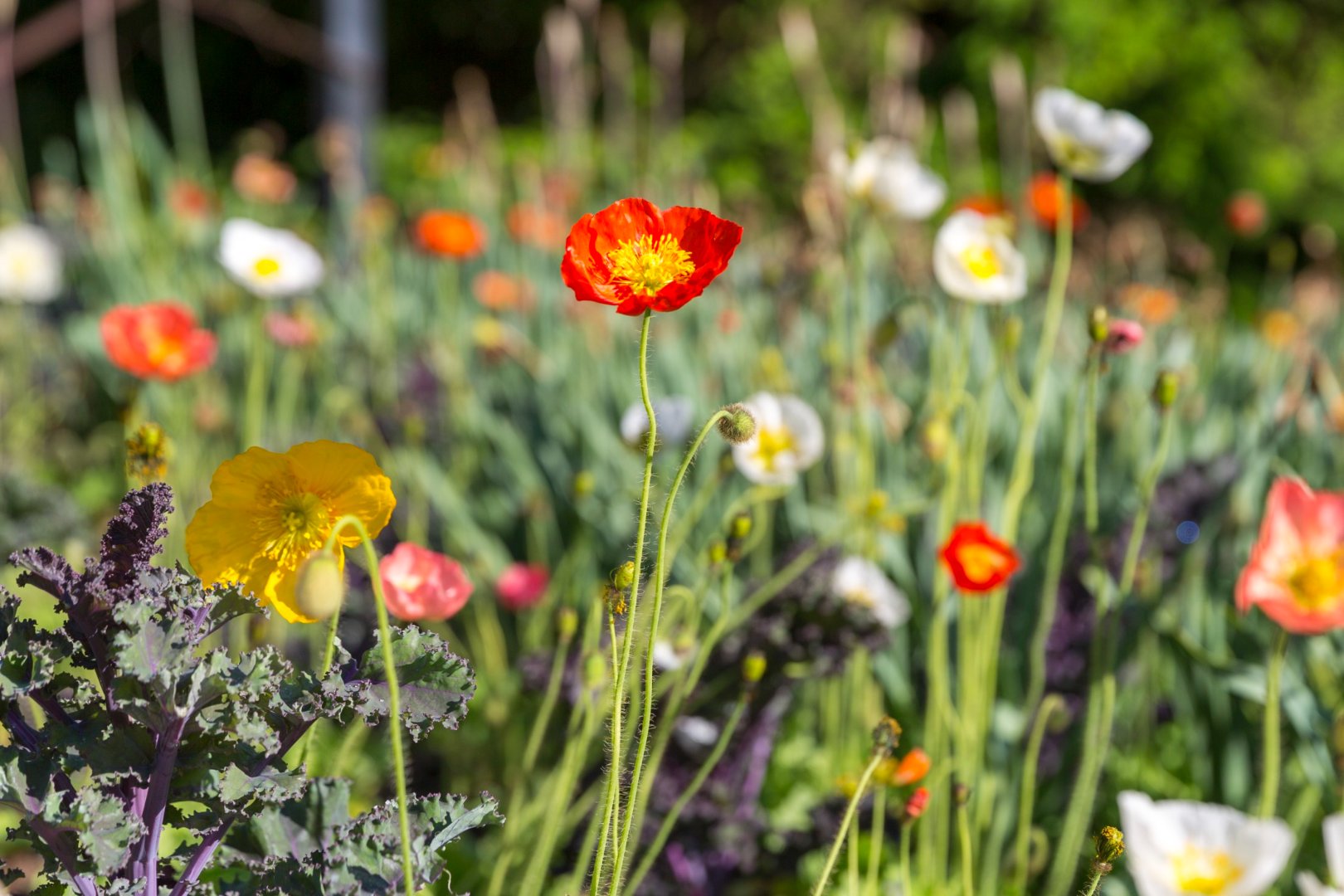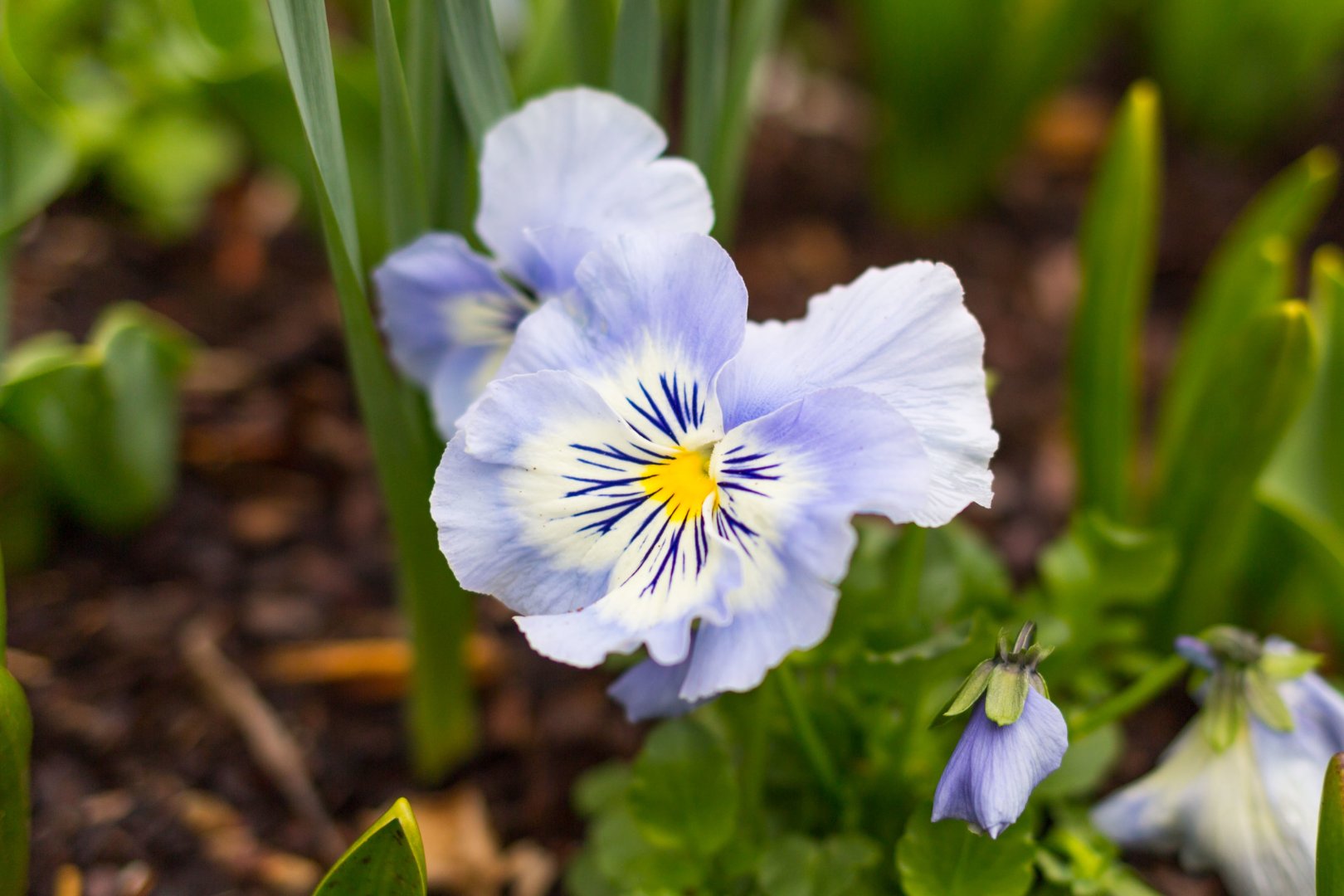Spring Awakening
Gardening is a lesson in humility. I know that after 30 years working here at Newfields. Spring Blooms presented by Wild Birds Unlimited is quickly approaching, and this year has been a particularly hard lesson. But, not to worry, as always, a trip to The Garden is sure to provide awe-inspiring fantastic florals around every turn.
So, on to our humbling lesson. Squirrels. Fat squirrels. Fat squirrels everywhere. So damn many fat squirrels everywhere. Rude fat squirrels. We fed them well last fall. An all-you-can-eat smorgasbord buffet of corn and pumpkin during Harvest. Corn for days. Perfect golden corn to gorge on for a month adding layers of fat and still plenty to store away for winter. Pumpkins. We fed them pumpkins for weeks. All the pumpkins–Yellow-striped Cushaw, Mellow Yellow, Flat White Boer, Blue Doll, Porcelain Doll, Grizzly Bear, Blue Hubbard, Pink Banana, Long Island Cheese. And fancy, fancy European pumpkins with fancy, fancy names like Rouge Vif D’Etampes, Galeux d’Eysines, Musquee de Provence, and Marina Di Chioggia. And still the greedy fur-covered monsters were not satiated.
So fat they could barely move yet they wanted more. As soon as we put the tulip bulbs out they began to consume them. They should have been in a food coma by then but no, like post-apocalyptic robots with sharp teeth and twitching tails they attacked our tulip bulbs. First, they found our bulbs for containers. We pot these in one-gallon pots, place them on the ground, then cover them in mulch for their winter chill period. When they start to emerge in spring we transfer them into our large containers all over the campus. Works beautifully as a rule. Apparently squirrels firmly believe rules are made to be broken.
It wasn’t long until the squirrels were decimating tulips planted in the ground. Some beds received minor predation, some beds received nearly total predation. Every bed received some damage which is to be expected. Tulip bulbs are tasty to squirrels, chipmunks, mice, and voles. You can almost be guaranteed of losing some. They even ignored the PlantSkydd, a repellant that has often saved bulbs. This year they acted like we sprinkled on paprika.
If only it ended with winter consumption. I think the most painful losses come in spring as the bulbs emerge. One thinks they are safe. One is thinking wrongly. The damn squirrels dig the sprouting bulb eating half of it, or they chew up most of the green growing bits. The really hateful ones wait until the flower bud is showing color then bite it off AND LEAVE IT LAY ON THE GROUND. The audacity.

Does the Great Squirrel Tulip Carnage of 2023 mean no flowers for this year’s Spring Blooms presented by Wild Birds Unlimited? Mercy no. We would never let that happen. We do not rely on one plant for our spring show, especially not a high maintenance “I’m not high maintenance” thing like tulips. We plant lots of spring-flowering bulbs. Two of the earliest spring bulbs are winter-aconite (Eranthis hyemalis), bright gold and often visited by bees, and snowdrops (Galanthus species), lovely nodding heads of white with crisp green markings. When you see these you know you are close to spring.
Wonderfully fragrant hyacinths in blues, pinks, and yellows are scattered throughout. Dainty small-flowered jewels like intense blue Siberian squill (Scilla siberica), and the many blue shades of grape-hyacinths (Muscari species) appear early for Spring Blooms.
Daffodils (Narcissus species) are everywhere at Newfields blooming from February into May. These tough beauties can be pure yellow or white or either of these colors with accents of green, orange, and pink. They may have simple trumpets or huge blousy centers on the flowers. They are deer- and rodent-proof, tolerate shade, and can be left undisturbed for years. They make lovely long-lasting bouquets too.

Coming near the end of the Spring Blooms bulb display, ornamental onions (Allium species), come mostly in shades of purple. The massive ‘Ambassador’ has heads measuring several inches across atop stems that are three feet tall. Others, like Allium schubertii, are shorter but their firework blooms are a foot across. The small purplish flowers are on stems of various lengths so the effect truly is like an ever-expanding firework going off.
To further ensure a good Spring Blooms show we add in thousands of flowering plants and even vegetables! Chief among the flowering plants are the pansies and violas. These low-growing fragrant beauties tolerate our constantly fluctuating spring weather like no others. There are no major cultural or performance differences between pansies and violas so buy what you like. Just to mess with your head a little bit I will tell you pansies are violas but violas are not pansies. Go ahead and ponder on that when you wake up in the middle of the night.
Other flowering annuals we like are snapdragons, diascia, ranunculus, and poppies. This year I am trying petunias–a good many petunias in fact. They are very cold-tolerant once acclimated, but it is a bit of a gamble perhaps. If I am not around after this spring, you may have a clue as to why. We use a few perennials like columbine and brunnera that are good for permanent garden locations after Spring Blooms. Fingers crossed the delphinium on order comes in happy and fully budded. It is hard to beat that blue in The Garden.
We use several greens for spring color: cabbage, kale, mustard, lettuce, Chinese cabbage, Swiss chard. Use these in your home pots and landscape so you can enjoy them in the garden and in the kitchen. My favorite kales are frilly burgundy ‘Redbor’ and dark smoky green ‘Laciniato.’ ‘Tokyo Bekana’ Chinese cabbage brightens up things with gorgeous chartreuse ruffled leaves.
So, squirrels, go ahead. Try to stop us from having Spring Blooms. We have a plan to deal with your nonsense. And we have hawks in the sky above you. Hungry hawks…
Exhibition Credits:
Spring Blooms is presented by Wild Birds Unlimited. Lead support for the River of Bulbs is provided by Catherine M. Turner.
Image Credits:
Guests walk along the Horticulture Society Overlook.
View of the Garden for Everyone. Artwork: Pablo Serrano (Spanish, 1910–1985), La Hermana del Hombre Boveda, 1963–1964, bronze, 38 × 34 × 40 in. Indianapolis Museum of Art at Newfields, Gift from the Joseph Cantor Collection, 1987.96 © 2023 Pablo Serrano / Artists Rights Society (ARS), NY






